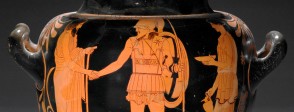Explore the picture scene with the students. The Explore a Greek picture resource in For the classroom asks the students to look at the scene section by section and would make a good starting point. If you prefer to look at the whole scene straight away, there is a hi-res image in For the classroom. You should aim to discuss who all the different characters are in the scene and various possibilities for what they may be doing based on the visual evidence – when discussing with students, insist that they back up their ideas with evidence from the picture or firm prior knowledge. After gathering different ideas, introduce the interpretation given by archaeologists.
Once you have explored the image, there are many directions in which the students could carry on their investigations of the Greek world. A few are given below.
Ask the students to imagine that the scene is taking place on one particular day. Pose the question of what each character may have been doing in the two or three days before. This question offers an opportunity to cover all the main aspects of daily life in Greece or Athens specifically for both men and for women: work, military training, religious practices, physical exercise, drinking parties, political activities. The students might like to give each character a proper Greek name and thus personalize their study and what they find out. The results could be presented as a daily calendar of activities. Similarly, you could pursue the scene forward in time: at the time that the pot was made, Athens was engaged in a number of conflicts, for example, Kimon’s expedition to Egypt in 450 BC and operations in Boiotia (447 BC) and Euboia (446 BC). Students could imagine the warrior is about to leave for one of these campaigns and find out more about what happened.
Greek houses, dress and education are other themes that emerge from studying the experiences of individuals. The topics allow discussion of differences between men and women. The view that parts of the house were designated as specifically for men or women has been questioned recently, but it is the case that on certain occasions, such as the (all-male) symposia (drinking parties), those spaces were isolated from the rest of the house.
Look at the two pots in For the classroom that show women engaged in spinning and making cloth. Identify the different stages of making cloth – these could be used for some sequential or instructional writing. Compare the scene on the pot in New York with the video of weaving in For the classroom. The pot in New York was probably made for a wedding and scenes similar to the one on the jug from the British Museum were sometimes depicted on pots put in graves. What message do the students think they were meant to convey in these two contexts?
Bring in a selection of different modern fabrics to explore. Give the students magnifying glasses so they can see the weave of threads. The principle of weaving can be demonstrated using paper strips. Try some aspects of the hand manufacture of cloth such as spinning, dyeing the yarn, weaving and sewing. Students can make spindles using wooden dowel and air-drying clay. Buy some washed fleece to spin with. Try vegetable dyes to see what colours you get. Try weaving on card, or braiding or using a lucet – a two-pronged weaving comb. When the students have had a go, ask them to consider what it must have been like to do this kind of work and how it affected the pace of life. What do they think the women did as they spun and wove?
Was life better for women in Sparta than it was in Athens?
A general comparison of life in Athens and Sparta is a good enquiry and could be done starting with the investigation suggested above. There are several resources in For the classroom that will help with this. However, it gives more edge to the enquiry to focus on the lives of women as the students will be able to reflect on the fact that women had relatively more respect and freedom under the Spartan regime. The mini-lesson on Greek women in For the classroom will be useful in investigating the different aspects of the role of women.
Why are pots so helpful in studying the ancient Greek world?
Ask pupils to think about what kinds of objects would or could survive for thousands of years based on materials, quality of construction and climate. Talk about the hard wearing nature of ceramics and how they are virtually indestructible. Try an experiment to show how even a broken cup or plate can be re-assembled easily. Once you have discussed durability, move on to the shapes of pots – you can print off a variety of shapes from the British Museum website or the internet. Ask students to work out what the different shapes were for and what this tell us. Print out examples of fine and coarse wares and discuss what extra information this provides. Compare the jug showing the woman spinning with the plain black-glaze flask and the coarseware cooking pot in For the classroom. Discuss both the difference in likely cost and the difference in usefulness as evidence. You can then move on to the Greek and specifically the Athenian practice of painting scenes on pots. The interactive about pots as evidence in For the classroom will help give a sense of the range of topics about which painted pottery informs us. If you think it suitable for your students, you could introduce the issue of the pots showing an interpretation of life rather than reality itself – use the analogy of whether TV or magazine ads show the world as it actually is. A good final question is to ask what we cannot learn about life in ancient Greece from the scenes on pots.


